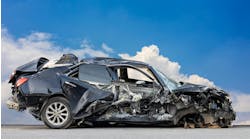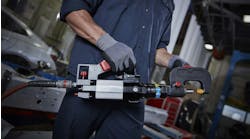Consideration for the next generation of collision repair professionals is critical, but it can be a difficult concept to flesh out. Discussing succession doesn’t always result in straightforward answers.
There is, however, an opportunity to garner interest for future repairers through trade school programs that grant both an education and real-life experience. Across the nation, many of these programs are shaping the minds of individuals who will eventually lead the way into collision repair’s future.
One such program exists at Minnesota State College Southeast in Winona, Minnesota. This school’s Auto Body Collision Repair Technology program has one particularly intriguing component: Former program head Tom Brandt is retiring and one of his former students, Brandon Boynton, has been chosen by the school to take over.
Work Together
Brandt began teaching for the program in 1986. He had actually been a student in it as well. He graduated in the spring of 1978, back when the school was called Winona Area Vocational Technical Institute. Boynton graduated from MSC Southeast in 2014 as a student under Brandt.
“I can remember sitting in class even way back then thinking how it'd be fun to share my knowledge (which I really didn't have a whole lot of at that point), with an up and coming group of techs.” Boynton said.
Passion for teaching is not the only thing Boynton and Brandt share. There are many similarities between the two, including the fact that they both have previous work experience with Fred’s Body Shop in Winona.
Additionally, the timing of their involvement as instructors with the program is also coincidental.
“I'm 28 now starting out and that's exactly how old [Brandt] was when he took over the program as well,” Boynton says. “It was meant to be.”
To prepare for this transition, the two have spent the past year working alongside each other, no longer as student and teacher, but as colleagues instead.
“The best explanation I can give is that it was comfortable,” Brandt says. “We worked well together. He had a solid background in the industry and he remembered what it was like being a student.”
For Boynton, the opportunity to work with Brandt has proved beneficial as he navigates all of the newness that comes along with it, from managing the auto body shop to helping with administrative tasks, inventory, general maintenance and more.
“Don't forget about trying to work in a little bit of teaching, too, to give a high quality education to a large group of beginner technicians,” Boynton says. “It’s a lot on your plate, so it'd be pretty easy to get overwhelmed. But luckily I've had the opportunity to work alongside Tom and see all these moving parts.”
Embrace Change, Honor Tradition
The collision repair industry has undergone massive amounts of change over time. Addressing those shifts and potential challenges is important in order to properly prepare students.
Brandt’s career has given him the opportunity to see many facets of the industry over the years, from his previous experience teaching and consulting for I-CAR to writing for auto body magazines, working as a collision repair technician and more.
“The technologies that have developed over my career like computer databases, resources, computerized measuring and the use of digital photography have changed things. Cell phones have changed things immensely. Students are learning how to use their devices to document and to do research and to use the internet,” Brandt says. “Even to find out how to get a door handle off, it’s oftentimes faster to search a YouTube video than it is to go to a database.”
Brandt cites other changes like the shift from full-frame to unibody vehicles, metallurgy and the changes in materials used and even the change from relatively simple welding techniques to vehicle specific techniques that have a more involved process.
While some of the content being taught has and will continue to change, the core of the teaching methods implemented by Brandt is something that Boynton anticipates keeping the same.
“I'm going to do everything in my power to maintain and build off of what he's established already,” Boynton says. “[Brandt] has been such an inspiration to me. The auto body program wouldn’t be here without him.”
As a student, Boynton recalls Brandt implementing a hands-on approach while simultaneously incorporating critical thinking classes that went into why mechanical components do what they do. This helped get students into the mindset of becoming a well rounded technician.
This is something that Boynton kept with him beyond his time as a student and into the multiple collision repair jobs that he has held prior to his current role as an auto body collision repair technology instructor.
“[Boynton] was always more than willing to get involved in a project and try to absorb as much as he could. He was a good student.” Brandt says. “When he finished the program he even mentioned to me that someday he’d like to teach. I think it was in his mind the whole time that he wanted more than just fixing the cars. He wanted to help people learn to fix cars.”
The Future Awaits
Brandt strongly believes that programs such as the one at MSC Southeast fuel opportunities for independent shops to find real talent. This is especially crucial considering the current labor shortages felt throughout the aftermarket.
But shops need to be willing to put in the work, says Brandt. Many large companies in the industry are able to put students through school and ultimately recruit individuals that way. Brandt says that shops can use this strategy as well.
“If shops want to play a role in it, they need to get involved and look at how they can help sponsor a student or intern them while they’re in the program,” says Brandt. “There are opportunities in both directions for the students, and it's more important that a student is fitted to the shop's personality, be it they're better in a small facility or a larger operation.”
Boynton looks forward to hearing from students in the coming years about their successes across the industry. One of the most rewarding parts of teaching for him is getting new repair professionals excited about all the possibilities that lie ahead.
Even though Boynton has built up his resume to successfully assume this new role, it is about more to him than paving his own career. It’s about carrying on what he’s learned from Brandt and continuing to inspire students.
“It’s pretty good to be able to take over for your mentor and let him ride off into the sunset.” Boynton says.




